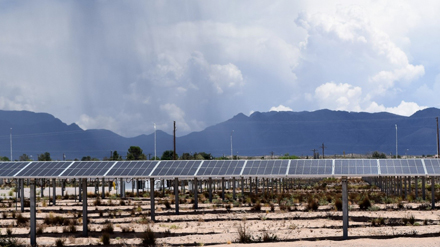
Using the Sun to Produce Green Plants and Green Energy
‘Planting’ solar panels on agricultural lands may prevent crop loss and generate clean energy
Higher temperatures caused by climate change threaten crop yields and ranch animal health, but a team of researchers from the Agricultural Research Service (ARS) has a plan that will not only save crops and livestock but help power farms and the nation as well.
The plan involves placing solar panels in Southwestern U.S. farm fields and ranches. In addition to producing electricity, shade from the panels will provide cover that can prevent plants and animals from overheating. The results will be both green crops and green energy – energy that can also produce revenue for farmers and ranchers.
According to Derek Whitelock, agricultural engineer at the ARS Cotton Ginning Research Laboratory in Las Cruces, NM, the United States needs more solar panels to produce renewable energy. Since a lot of ranch and farmland is flat and sunny, the idea of merging the two in one location makes sense.
“There’s an idea that uses land for both growing food and making energy from the sun, called ‘agrivoltaics’ – agriculture + photovoltaics,” he said. “We’re working on research to explore agrivoltaics in western states, like New Mexico, where there’s lots of sunshine and not much water.”
One of the key elements of the plan, in addition to capturing sunlight with the solar panels, is to provide shade for crops to give them respite from the heat.
“During the summer, in the middle of the afternoon, the sun is really bright and hot,” Whitelock said. “The solar panels will provide shade for crops during the hottest times of the day so they will be cooler, grow more, and need less water.” Livestock can also graze under elevated panel arrays for relief from the heat.

A typical utility-scale single-axis tracking installation built on fallow ground in Las Cruces, NM. The solar panels are elevated 4 feet above the ground on pedestals and rotate from east to west to follow the sun. (Photo courtesy of Derek Whitelock)
The research team is working with several types of agrivoltaic panel arrays that are mounted in fields on steel supports. Some arrays are fixed to face the southern sky, while others have motors that track the sun so the panels get maximum sunlight throughout the day. The panels are set far enough apart to allow tractors and other farm equipment to move between them, and some are set 8 to 10 feet high to allow livestock to graze under them.
Each solar array contains 60 photovoltaic cells that absorb light energy from the sun. Solar energy forces electrons within the semiconductor material to create a voltage potential, which causes electric current to flow. The electricity generated by the photovoltaic panels on farms can be used on the farm to power irrigation pumps, refrigeration, and other processing equipment; stored in batteries for later use; or sold to the local electric grid.
“Agrivoltaics has been a research subject in Europe, Japan, and Korea for about 10 years,” said Paul Funk, a retired ARS scientist who continues to support the project. “Our task is to build on existing research, particularly by looking at crop responses to partial shade and to shade at various times of day.”
Funk said that every plant has its own “ideal” light requirement, called the light saturation point, which is typically one half or less than the amount of light available on a clear day.
“Excess light can heat a plant; plants evaporate water to keep cool. When a plant can no longer take up enough water to keep cool, the pores in the leaves close and photosynthesis stops,” Funk said. “On a hot afternoon a plant in full sun may not be growing at all!”
“These situations can be mitigated by partial shade, explaining why, in many agrivoltaic experiments, plant growth and crop yield are higher under agrivoltaics than in the unshaded control plots,” Funk explained. “There is also potential for the plants to help the solar panels produce more energy. Plants evaporate water, which lowers the air temperature around them. This cools the photovoltaic panels from beneath, and photovoltaic panels produce more electricity at lower temperatures.”
Providing a cooler space for livestock is also very important; high temperatures can reduce an animal’s feeding efficiency, growth rate, and reproductive success, while increasing illness. The total economic loss from heat stress in dairy cows in some Southwestern states is nearly $170 million per year.
According to Brandon Bestelmeyer, ecologist at the ARS Range Management Research unit at Las Cruces, the agrivoltaics project combines two products (crop or range production and solar energy), and that synergy creates benefits greater than either one alone could achieve.
“The combination of solar energy production with agriculture may have some costs, but may also have benefits for numerous ecosystem services, including ag production, water savings, biodiversity, and carbon storage,” he said.
The ARS researchers in Las Cruces have been collaborating with colleagues at New Mexico State University to evaluate alternative agrivoltaic designs and select sites on cropland and rangeland. At those sites, the team will conduct experiments to test the designs’ effects on crop and range production and environmental measurements, such as shading throughout the day, ground temperatures, and soil water. These initial experiments will be the basis for creating novel designs in the future.
“Agriculture and energy development are typically thought of as competing land uses where stakeholders with one or the other interest are losers,” Bestelmeyer said. “Agrivoltaics research seeks to provide a win-win for all stakeholders.” – by Scott Elliott, ARS Office of Communications
